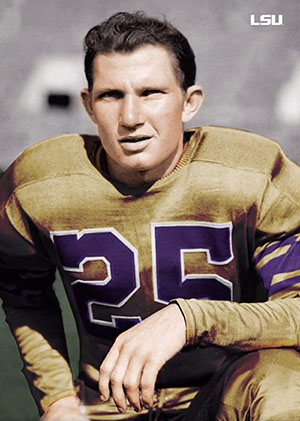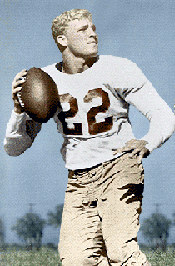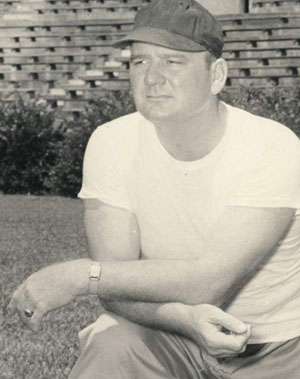LSU Pivotal Football Moments
pivotal college football moment: A decision by a coach or athletic director that changes the momentum of a program or an action by a player that changes the momentum of a game.
pivotal college football moment: A decision by a coach or athletic director that changes the momentum of a program or an action by a player that changes the momentum of a game.
Future Pro Football Hall of Famer Steve Van Buren left LSU after the 1943 season. The next year, a 17-year-old tailback named Y. A. Tittle arrived in Baton Rouge. Yelverton Abraham followed his older brother Jack to Louisiana but to Baton Rouge, not New Orleans, where Jack had played for Tulane from 1939 through 1941.
As a boy in Marshall TX, Y. A. spent hours in the back yard throwing a football at a tire swinging from a tree trunk and to his younger brother Don. Sammy Baugh of TCU and the Washington Redskins was the budding tailback's idol.
Unfortunately, the coach at Marshall High School in the Northeast corner of Texas believed in a single-wing formation that ran the ball the vast majority of the time. So Y. A. saw little action as a forward passer.
"With the utilization of a running offense and me on the bench," Tittle recalled, "Coach Magrill decided to try me out as a cornerback on defense. To my own surprise, I discovered that I really enjoyed driving my shoulder into a ball carrier and knocking him down. It was an incredible rush, but my desire to be a passing quarterback was still my first love."
Tittle's defensive skills would stand him in good stead when he went to LSU in an era of limited substitution in college football.
Fortunately, Marshall hired a new coach who believed in throwing the football. "He continued to use the single-wing formation ... and utilized me as a tailback with instructions to throw the ball whenever I got the chance." By Tittle's senior year, Marshall was passing the ball more than any high school team in the state.
The 180-lb Tittle was as big as many linemen of that day. And, best of all, his asthmatic condition earned him a 4-F draft classification, which meant he didn't have to enter the military. As a result, he was highly recruited. Having seen LSU play a number of times and impressed with Coach Bernie Moore, Y. A. committed to The Ole War Skule. He liked the fact that Tiger players lived in an athletic dorm whereas Green Wave athletes lived in boarding houses. But the biggest factor was that LSU's Army ROTC program prohibited participants from playing football. So Y.A.'s competition would be other 17-year-olds and not Army enlistees transferring from other schools.
But a funny thing happened on his way to Baton Rouge. Three days before he was to report to LSU for summer school, Y.A. succumbed to pressure to go to Texas instead. "It will help your business career after college." While working a summer job in Austin, he roomed with another Longhorn freshman-to-be named Bobby Layne. (What are the odds of two future Hall of Fame quarterbacks sharing a room as teenagers?)




L-R: Y. A. Tittle, Bernie Moore, Bobby Layne, Red Swanson
Within a few weeks, Y.A. regretted having gone to Austin. He felt like a fish out of water. He didn't like Layne's partying lifestyle – "He was 17 years old going on 35, and I was 17 going on 14." – nor the thought of competing against a first-team All-State quarterback at Texas. So he told his mother, who called Coach Moore to inform him of her boy's situation. Bernie gave his line coach, Red Swanson, simple orders. Drive to Austin and don't come back without Tittle.
Y.A. was ready to go as soon as Red walked into the boarding house the next morning. Since he had not yet enrolled at Texas, Y. A. violated no rules when he agreed to go to LSU. But before they left the Lone Star capital, Swanson insisted his new recruit phone Texas Coach Dana Bible and tell him of his decision.
Scared to death at the thought of talking to Bible (a sign of the youth's immaturity), Y.A. tried to wiggle out of making the call, citing the fact that the coach wouldn't be in his office on a Sunday morning. But Red looked up Bible's home phone number. Y.A. dutifully went to a phone booth and dialed the number. "To my relief, no one was at home."
Tittle started at quarterback for LSU for four years before beginning an illustrious pro career that landed him in the Pro Football Hall of Fame.
References
The Fighting Tigers II: LSU Football 1893-1980, Peter Finney (1980)
Game of My Life LSU Tigers: Memorable Stories of Tigers Football, Marty Mule (2006, 2011)
Nothing Comes Easy: My Life in Football, Y. A. Tittle with Kristine Setting Clark (2009)
What It Means to Be a Tiger, Ray Glier (2009)
The Fighting Tigers II: LSU Football 1893-1980, Peter Finney (1980)
Game of My Life LSU Tigers: Memorable Stories of Tigers Football, Marty Mule (2006, 2011)
Nothing Comes Easy: My Life in Football, Y. A. Tittle with Kristine Setting Clark (2009)
What It Means to Be a Tiger, Ray Glier (2009)